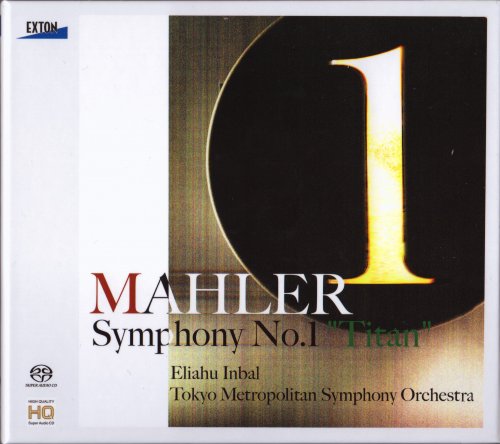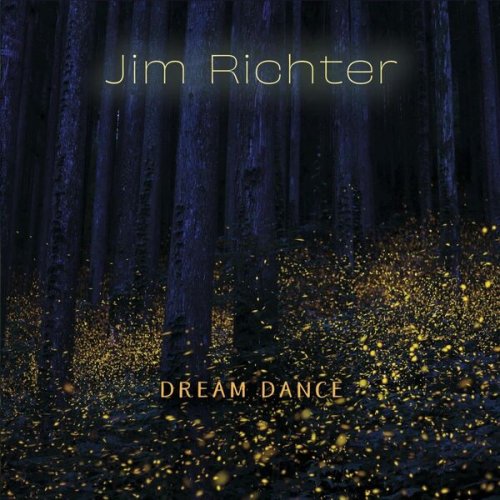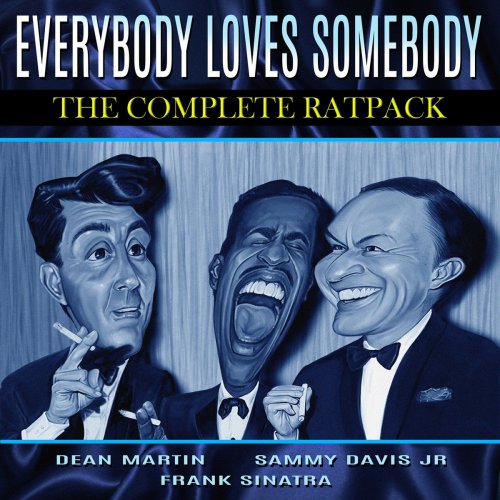Tokyo Metropolitan Symphony Orchestra, Eliahu Inbal - Mahler: Symphony No. 1 (2012) [SACD]

Artist: Tokyo Metropolitan Symphony Orchestra, Eliahu Inbal
Title: Mahler: Symphony No. 1
Year Of Release: 2012
Label: Exton
Genre: Classical
Quality: DSD64 image (*.iso) / 2.0 (2,8 MHz/1 Bit)
Total Time: 00:51:06
Total Size: 2.07 GB
WebSite: Album Preview
Tracklist:Title: Mahler: Symphony No. 1
Year Of Release: 2012
Label: Exton
Genre: Classical
Quality: DSD64 image (*.iso) / 2.0 (2,8 MHz/1 Bit)
Total Time: 00:51:06
Total Size: 2.07 GB
WebSite: Album Preview
01 - 1st movement - Langsam. Schleppend (Slowly. Dragging) - 15:01
02 - 2nd movement - Kräftig bewegt, doch nicht zu schnell (Moving vigorously, but not too fast) - 07:49
03 - 3rd movement - Feierlich und gemessen, ohne zu schleppen (Solemn and measured, without dragging) - 09:32
04 - 4th movement - Stürmisch bewegt (With stormy emotion) - 18:49
Eliahu Inbal conducts the Tokyo Metropolitan Symphony Orchestra for this recording of Mahler's First Symphony 'Titan'. This Exton Laboratory Gold Line Hybrid Stereo disc is a high quality non-compressed Japanese Import SACD. Recorded on a custom Sony DSD recorder, this audiophile SACD is packaged in an XRCD-like luxury digipak. This disc includes a booklet with detailed microphone and equipment diagram and placement used for each individual recording! Superior quality Japanese Import SACD, manufactured in Yokohama, Japan. Only the best recordings - technically and artistically! This Hybrid SACD contains a 'Red Book' Stereo CD Layer which is playable on most conventional CD Players!
Gustav Mahler - Symphony No. 1 in D major ("Titan")
Description by Steven Coburn
Mahler's First Symphony was originally conceived as a tone poem in two parts. Loosely based on Jean Paul's novel Titan, the structure was this: Part I: "From the Days of Youth," Music of Flowers, Fruit and Thorn - 1. Spring and No End; 2. Flowers; 3. In Full Sail; Part II: "The Human Comedy" - 4. "Stranded!" Funeral March in the Style of Callot; 5. D'all Inferno al'Paradiso (From Hell to Heaven). These titles were accompanied by more extensive programs describing the metaphorical content of each movement. In Jean Paul's Titan we have a youth gifted with a burning artistic desire that the world has no use for, and who, finding no outlet or ability to adapt, gives way to despair and suicide. Mahler apparently saw himself in this figure, as he described this work as autobiographical in a very loose sense. On the other hand, the music, some of which Mahler actually accumulated from various earlier works, contradicts this program in so many ways, especially in the triumphant conclusion, that Mahler later withdrew it. He eventually came to scorn the application of specific programs to his symphonies in general.
Beyond Mahler's suppression of the program, there were other changes made before the symphony achieved its final form: the orchestra was expanded and the original second movement, entitled "Blumine" (Flowers) was dropped. This movement, the only surviving piece from Mahler's incidental music to Scheffel's Der Trompeter von Säkkingen, although having thematic ties to the rest of the symphony, is stylistically different, being scored for a much smaller orchestra.
The primary source material for the remaining movements of the First Symphony is Mahler's Lieder eines Fahrenden Gesellen (Songs of a Wayfarer). The material of these songs, specifically the first and second, is not only quoted but also used as thematic material in the symphony, creating additional programmatic implications. Mahler's First Symphony is a stunning achievement for so young a composer, and despite its convoluted genesis is a fully mature, integrated and highly effective work.
The first movement, Langsam Schleppend (Slow and Dragging), opens with an introduction invoking nature, eventually with cuckoo calls and distant fanfares. The principal theme is from the song "Ging heut' morgens übers Feld" (I Went Out This Morning Through the Fields) and is developed in a standard sonata form. The second movement, Kräftig bewegt (Strongly moving), is a lusty and hearty Austrian Ländler replete with yodels and foot stomping. The slower and wistful Trio conjures feelings of nostalgia and longing. Based on a woodcut depicting animals carrying a hunter to his grave, the third-movement funeral march, Feierlich und gemessen (Solemnly and measured), is deeply ironic. Mahler uses the folk song "Frère Jacques" in a lugubrious minor, played by a muted double bass solo. The central Trio is an evocation of tawdry Viennese cabaret music.
Mahler's original program for the Stürmisch bewegt (Stormy) finale called the movement's dramatic opening "the sudden outburst of a wounded heart." After a long and violent beginning invoking the torments of hell, including a vehement march derived from the first movement, the music subsides into a yearning theme. After a return to the march, Mahler interrupts the mood with a transformative fanfare that eventually leads to a triumphant conclusion.
Gustav Mahler - Symphony No. 1 in D major ("Titan")
Description by Steven Coburn
Mahler's First Symphony was originally conceived as a tone poem in two parts. Loosely based on Jean Paul's novel Titan, the structure was this: Part I: "From the Days of Youth," Music of Flowers, Fruit and Thorn - 1. Spring and No End; 2. Flowers; 3. In Full Sail; Part II: "The Human Comedy" - 4. "Stranded!" Funeral March in the Style of Callot; 5. D'all Inferno al'Paradiso (From Hell to Heaven). These titles were accompanied by more extensive programs describing the metaphorical content of each movement. In Jean Paul's Titan we have a youth gifted with a burning artistic desire that the world has no use for, and who, finding no outlet or ability to adapt, gives way to despair and suicide. Mahler apparently saw himself in this figure, as he described this work as autobiographical in a very loose sense. On the other hand, the music, some of which Mahler actually accumulated from various earlier works, contradicts this program in so many ways, especially in the triumphant conclusion, that Mahler later withdrew it. He eventually came to scorn the application of specific programs to his symphonies in general.
Beyond Mahler's suppression of the program, there were other changes made before the symphony achieved its final form: the orchestra was expanded and the original second movement, entitled "Blumine" (Flowers) was dropped. This movement, the only surviving piece from Mahler's incidental music to Scheffel's Der Trompeter von Säkkingen, although having thematic ties to the rest of the symphony, is stylistically different, being scored for a much smaller orchestra.
The primary source material for the remaining movements of the First Symphony is Mahler's Lieder eines Fahrenden Gesellen (Songs of a Wayfarer). The material of these songs, specifically the first and second, is not only quoted but also used as thematic material in the symphony, creating additional programmatic implications. Mahler's First Symphony is a stunning achievement for so young a composer, and despite its convoluted genesis is a fully mature, integrated and highly effective work.
The first movement, Langsam Schleppend (Slow and Dragging), opens with an introduction invoking nature, eventually with cuckoo calls and distant fanfares. The principal theme is from the song "Ging heut' morgens übers Feld" (I Went Out This Morning Through the Fields) and is developed in a standard sonata form. The second movement, Kräftig bewegt (Strongly moving), is a lusty and hearty Austrian Ländler replete with yodels and foot stomping. The slower and wistful Trio conjures feelings of nostalgia and longing. Based on a woodcut depicting animals carrying a hunter to his grave, the third-movement funeral march, Feierlich und gemessen (Solemnly and measured), is deeply ironic. Mahler uses the folk song "Frère Jacques" in a lugubrious minor, played by a muted double bass solo. The central Trio is an evocation of tawdry Viennese cabaret music.
Mahler's original program for the Stürmisch bewegt (Stormy) finale called the movement's dramatic opening "the sudden outburst of a wounded heart." After a long and violent beginning invoking the torments of hell, including a vehement march derived from the first movement, the music subsides into a yearning theme. After a return to the march, Mahler interrupts the mood with a transformative fanfare that eventually leads to a triumphant conclusion.
![Tokyo Metropolitan Symphony Orchestra, Eliahu Inbal - Mahler: Symphony No. 1 (2012) [SACD]](https://www.dibpic.com/uploads/posts/2021-12/1639715566_back.jpg)
Download Link Isra.Cloud
Tokyo Metropolitan Symphony Orchestra, Eliahu Inbal - Mahler: Symphony No. 1 (2012) [SACD]
My blog
Tokyo Metropolitan Symphony Orchestra, Eliahu Inbal - Mahler: Symphony No. 1 (2012) [SACD]
My blog

![Nicole Zuraitis - Holiday Up EP (2025) [Hi-Res] Nicole Zuraitis - Holiday Up EP (2025) [Hi-Res]](https://www.dibpic.com/uploads/posts/2025-12/1765478937_cover.jpg)






